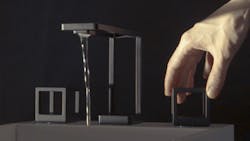It’s no secret that 3D printing/additive manufacturing is no longer just about prototyping, as the technology has been making serious inroads into manufacturing over the past decade. From creating key components for manufacturing subassemblies and prosthetics to jewelry and protective dog eyewear, 3D printing is continuously proving itself to be a viable means of production.
Largely missing from 3D printing applications, however, has been its use in producing standard consumer products—such as faucets. Until now.
Kallista, a designer of kitchen and bathroom fixtures, is using 3D printing to create its new Grid faucet. Produced using 3D Systems’ Direct Metal Printing (DMP), the Grid faucet is made in a combination of inert, oxygen-free 3D printing environments, using metal alloy powder materials and integrated software for metal additive design to produce parts within hours. To avoid rust and corrosion issues from long-term use, the faucets are printed with 3D Systems LaserForm 316L—a high-quality stainless steel 316 powder material.
3D Systems, founded by Chuck Hull (the inventor of stereolithography [SLA] 3D printing), specializes in multi-jet 3D printing, metal 3D printing and selective laser sintering (SLS) with 3D-printed nylon materials. The company focuses on production-level 3D printing with metal, plastic and nylon factory systems and a global parts production service.
While Kallista designs the Grid faucets, 3rd Dimension, an Indianapolis-based metal manufacturer specializing in 3D direct metal printing, produces them using direct metal printing on machines from 3D Systems.
Though 3D printing of consumer products is still far from commonplace, the Grid faucet is not the first example of a 3D-printed faucet to hit the market. DVX began offering 3D-printed products in 2015.
This video from 3D Systems shows the design and production of the Grid faucet.


